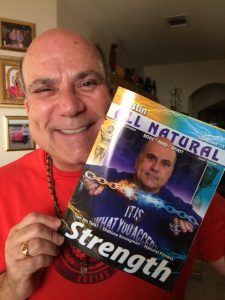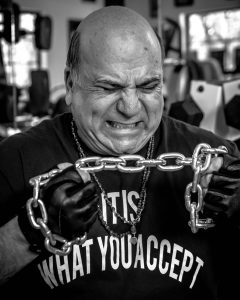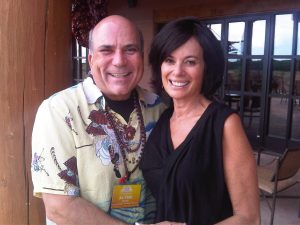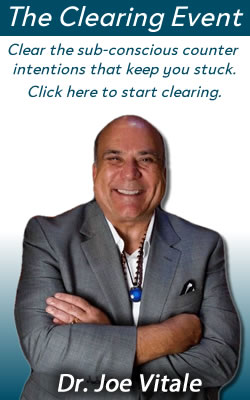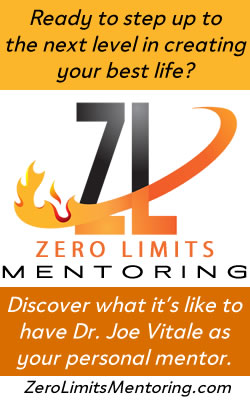Tag: mister fire
Find a Calf, Lift It
The following is the cover story feature article in this month’s issue of Austin All Natural magazine, by yours truly:
“Let me make you a paper weight.”
It was Dennis Rogers speaking. Many consider him the world’s strongest man. Celebrities call on him for advice on performing and getting strong. He’s performed over 2,600 feats of strength shows. He’s a legend.
We met over lunch. He wanted to give me a gift, or rather make one for me.
He wrapped his hands in a thin leather protective covering, and then began to bend a wrench before my eyes. I couldn’t comprehend how he did it. I had felt the wrench beforehand and it was a genuine metal tool, heavy and solid. But it bent like it was warm butter.
By now the kitchen staff had seen the bent wrench and saw the small lunch crowd forming around Dennis and me.
“Would you like me to roll a frying pan for you?” Dennis asked the cook and staff. “It can be a souvenir you can hang in the kitchen.”
They all agreed, their eyes bugged out and waiting.
Dennis pulled out a frying pan, put his fingers over the edge, and began to slowly roll it like it was a tortilla. It was astonishing to see. It was surreal. Dennis was clearly focused, breathing hard, putting his life force into his efforts.
He handed the completely rolled up pan, now of no practical use, to the chef.
None of us could believe it.
I had seen strongmen and feats of strength before. When I was in Russia, a man billed as the world’s strongest man – I guess there can be more than one – bent a heavy nail before my eyes. He, like Dennis, used sheer power and intense focus to get it done.
I admired it. I could see applications in other areas of life. I wanted to know more.
The origin of strongman feats of strength goes back to prehistory, maybe even back to caveman picking up boulders and protecting their caves.
The first of the recorded characters was probably Milo of Croton, an ancient Greek wrestler, circa 558 B.C.
His training was simple: find a young calf, lift it.
Next day, find a heavier calf, lift it.
Next day, find a heavier calf or cow, lift it.
It was an early exercise routine today named progressive overload. But that’s the ancient Greeks for you. They didn’t name it. They just knew the process made them stronger.
But feats of strength were performed throughout history, right into the circus and on the vaudeville stage throughout the 1800s.
As time went on, strength displays were broken into categories, such as power lifting and bodybuilding.
I admire men and women who use intention and strength to accomplish something the rest of us might consider virtually impossible.
- Julie Havelka, a competitive female strength athlete, wrote Personal Best: How to Train for the Sport of Strongman. She reveals the intensity of mind and muscle needed to accomplish these feats. Lifting huge stones, tractor tires, or small horses isn’t uncommon.
- Eugen Sandow (1867-1925), considered the father of modern bodybuilding, began his career as a sideshow strongman. The list of colorful characters goes on, and is alive today in people like Dennis Rogers.
- Joe Holtum, in the 1800s, would catch a cannon ball in his bare hands. He lost a finger or two along the way, but always drew a crowd.
- And I once saw a clipping about Joe Vitale – yes, the same name as mine – a circus performer in New York City in the 1900s who lifted over 500 pounds – with his teeth.
Some of these early strongmen, most notably Joseph Greenstein, whose stage name was the Mighty Atom, also pursued strength as a means of mental and spiritual development.
Authentic strongman and strongwomen don’t use magic tricks to get their results. They want to impress themselves as well as you.
This is one reason I’m attending Dennis Rogers and Dave Whitley’s Oldetime Strongman University Training in Austin September 19-20. http://www.dennisrogers.net/oldetime-strongman-university-seminar/
I want to learn what it takes to be a modern walking Hercules, able to bend nails, wrenches, frying pans or your car keys, but doing it as a type of meditation. Using it to stretch myself into bigger possibility thinking.
Dennis told me, “The area of strength that David Whitley and I will be teaching is the artistic display of physical strength. I say this because you must certainly build your body, particularly your core and grip, but it also requires a creative mind and artful presentation.
“It is the art of the old vaudeville and Coney Island strength stars. Men like Eugen Sandow, Siegmund Brietbart, Warren Lincoln Travis, and ‘The Mighty Atom.’ “
According to author and strength historian David Willoughby, “It was Sandow who raised feats of strength out of the grunt-and groan category and made them spectacular and entertaining.”
But it’s not about the bent item, it’s about learning to use your mind and muscle to get results. That’s priceless anywhere.
David Whitley said, “It is the bodily expression of the mind’s power.”
And that’s why I trained with the “old school” bodybuilders, like multiple Olympia winner Frank Zane, who advised me, “Watch your thoughts. Most people let their mind talk themselves out of what their muscle can do. Push past the voice.”
And Steve Reeves, the legendary early bodybuilder who played Hercules in the original movie, said he would visualize his muscles growing as he worked them. Arnold does the same thing.
It’s mind over muscle.
Dennis Rogers once told me that most people give up in trying to bend a wrench right before the wrench is going to bend. “They let their minds talk themselves out of what they can achieve,” he explained.
David Whitley said, “We tend to think of the physical first, but being strong is something that goes beyond the physical performance of feats and encompasses the entire being. It is a means of discovering, unifying and expressing the True Self.
“The essence of being an old-time strong man in my opinion is recognizing and acknowledging the infinite potential of the human mind. The ability to bend steel, rip decks of cards, etc., has its roots in the same place as every great invention or work of art we have ever seen: The Imagination.”
You can see how relevant this is to all aspects of life, not just in the gym or on stage. It’s about using your mind and body to achieve your intentions. It’s about training in a way to exceed your own “personal best” and proving to yourself and others that virtually nothing is impossible.
Now, stand back, as I’m going to break that chain around my neck on the cover of the magazine…
Ao Akua
Joe
PS – If you are in the Austin, Texas area, you can find the current issue of Austin All Natural at places like Central Market, Whole Foods, and leading edge book stores and yoga studios. You can read it online right here.
Loving Wayne Dyer
The passing this week of self-help author Wayne Dyer has shaken and saddened the world.
He influenced millions, inspiring them, educating them, being a light for the road ahead.
He wrote forty books, recorded numerous programs, and spoke to millions.
He changed my life, too, way back in the early 1980s.
I borrowed his books and cassettes from the public library. I watched him on television.
He was brilliant in articulating principles I had not heard before.
He was one of the first great living teachers in my life.
I still remember him talking about the difference in scolding a child, and scolding a child’s behavior.
They were two different things.
The child was never wrong, but their behavior might be.
The first audio program I ever heard of his was How to Be A No-Limit Person from Nightingale-Conant.
That was probably around 1980. I was still struggling but deeply searching, too.
Wayne’s program helped me rethink my own life, including my beliefs and behaviors.
He helped awaken me to inner powers and renewed optimism.
He helped get me through the dark night of my soul.
I also learned book marketing from Wayne.
I remember the story of him quitting his job in 1976, loading a station wagon with his first book (Your Erroneous Zones) and traveling the country for an entire year, going on every radio or TV show that would have him as a guest.
It was old school door-to-door marketing.
He was relentless and persistent in sharing his message to the world.
When he returned home, his neighbors said, “Hey, while you were on vacation, your book became a bestseller.”
Obviously, he made it one.
I never met Wayne in any formal way but we spoke at the same event for Hay House in Austin a couple of years ago, and I saw him once years beforehand.
“The next time you are contemplating a decision in which you are debating whether or not to take charge of yourself, to make your own choice, ask yourself an important question, ‘How long am I going to be dead?’ With that eternal perspective, you can now make your own choice and leave the worrying, the fears, the question of whether you can afford it and the guilt to those who are going to be alive forever.” – Wayne Dyer
We were walking along the beach in Maui, going in different directions, and I said hi to him.
He paused long enough to acknowledge me, but I kept walking.
He was with a friend and I was focused on my walk.
I’m certain he would have stopped and chatted, as I sensed his humbleness, serenity and friendliness.
But the moment passed.
And now Wayne Dyer, age 75, has passed.
I regret that I didn’t stop my stroll long enough to share a few words, and to thank him in person for influencing me, too.
The world will miss Wayne Dyer, but they will never forget him.
His contributions will live forever.
As will our love for him.
Thank you, Wayne.
You did well.
Ao Akua,
Joe
PS – A news report of the passing of Wayne Dyer is here: http://www.nbcnews.com/news/us-news/self-help-pioneer-dr-wayne-dyer-dies-75-n418556
Butterflies and Your RAS
How many butterflies do you see around you?
Right now, in your home or office, probably none.
But you will probably notice a few later today – maybe in a magazine photo, or on television, or out in nature – at least until my question evaporates from your consciousness.
Why?
In researching goal setting for my upcoming talk for the Texas Association of Magicians (TAOM) convention in Austin, Texas on September 6, 2015, I was reminded of our RAS.
RAS means Reticular Activating System.
It’s at the base of your brain stem.
It’s job is to basically sort through the millions of data bits surrounding you in any one moment to deliver the seven bits that are relevant to you.
Numerous authors gave their own names to this natural tool of survival and selection.
In 1960, Maxwell Maltz wrote a breakthrough book called, Psycho-Cybernetics. In it he called the RAS your “servo-mechanism.”
Seems like an odd name to me, but it worked for Maltz and legions of his readers.
Either way, there is something in you that will help you attract your intentions if you activate it.
So let’s look a little closer…
How does your RAS select what’s relevant?
Basically in two ways:
1. Anything to help you survive.
2. Anything related to a goal.
Survival is the default setting.
Your brain is designed to help you stay safe and reproduce.
You don’t have to think about it. It’s hard wired into your brain.
Most of the work of your unconscious is around the idea of keeping you here and assuring some aspect of “you” remains after you’re gone.
But you can also program your mind for additional filters.
For example, whenever you set a goal or intention, you are programming your mind to help you attract and achieve it.
You are inserting a new command into your RAS.
It will then begin to filter those 10,000,000 bits of data in every moment to deliver what is relevant to your goal or intention.
But how do you program your RAS?
The best way to get a new command into your brain is with a goal or intention that fulfills these three qualities:
1. Emotional
2. Vivid Imagery
3. Repeated
In other words, a goal needs to be fueled with emotion (love, hate, or fear are the biggies), it needs to be vividly clear as an image (the mind responds to pictures), and it needs to be repeated (to get it installed in your mind).
When I asked you to look for butterflies, I was temporarily turning on your RAS to look for butterflies.
Without an emotional reason to see butterflies, or a clear picture of what butterfly you wanted to see, and without repetition, you will soon forget all about butterflies.
This is true for anything you want to attract or achieve.
Your mind is designed to help you achieve your goals, but you have to tell it what you want.
Why not do that right now?
Here’s how:
1. Select a desire, goal or intention.
2. Find an emotional reason for wanting it.
3. Create or find a clear image of it.
4. Look at the image, and feel your desire for it, every day.
Of course, you still need to take action.
Wallace Wattles (of The Science of Getting Rich fame) said what you want will arrive through natural means.
Don’t expect a Hollywood movie style Harry Potter production of your goal, but do welcome it if it comes that way.
Expect Miracles – and do what you are inspired to do.
Meanwhile, enjoy the butterflies.
Ao Akua,
PS – I’m speaking at the TAOM convention because I am a lifetime member of the Society of American Magicians, the organization founded by Harry Houdini. But I’m far less interested in magic tricks as I am in real magic. If you want real magic, too, then please click right here.
It Is (Part Two)
What would be better than thinking or saying “It is what it is”?
As I wrote in my April 9th post, the above line is victim thinking.
It leaves little room for hope, change or action.
People say it to shrug and give in to what they think is unchangeable reality.
What would be better?
It occurred to me like a flash of inspiration that this line would be more accurate and empowering: “It is what you accept.”
In other words, reality is what you accept.
“It is what you accept.”
Someone asked me about the phrase, “It is what I decide.”
“Decide” could work, except it’s not entirely true.
I had two friends die within a week, one totally unexpected.
If I could “decide,” I would decide to have them live.
I can’t do that.
But I can accept their passing.
“It is what I accept.”
By accepting what I can’t change, I still live in agreed upon reality while acknowledging my power in the acceptance.
It’s a bit like the famous advice known as The Serenity Prayer:
- God, grant me the serenity to accept the things I cannot change,
- The courage to change the things I can,
- And the wisdom to know the difference.
While most people associate the famous prayer with AA, it actually came out of a struggle in politics against evil.
According to Susan Cheever, “…it may come as a surprise to learn that the prayer was originally conceived not as an antidote to addiction but in response to the barbaric evil of Nazi Germany that threatened civilization itself during World War II. Written during the darkest depths of the war by the theologian Reinhold Niebuhr, a first-generation German-American, the prayer captured the dreadful ethical predicament faced by Niehbur and his fellow German anti-Nazi émigrés in the United States, who were safe from persecution but powerless to intervene against Hitler.”
The “wisdom to know the difference” is the key.
Too many of us give in without checking in.
We don’t use our wisdom.
Many better advice is from a Mother Goose rhyme from 1695:
- For every ailment under the sun
- There is a remedy, or there is none;
- If there be one, try to find it;
- If there be none, never mind it.
At least with this new slogan, you can sense that you have choice.

With "Divorce with Grace" author Lori Anderson, celebrating my new "Secret Prayer" book and new albums. Note my T-shirt.
If you are backed into a corner, you can choose to see options or you can choose to surrender.
Either way, you get to choose what you accept.
Notice that the new line gives you more power.
You may or may not use it of course.
Creating your own reality is all about choice and awareness.
I am sure you will make the right decision to be the most empowered.
Whether you use it or not will depend on what you accept.
But notice that it’s entirely up to you.
“It is what you accept.”
Ao Akua,
PS – Remember, check out Miracles Coaching to better grasp what I teach.
The Surrender Experiment
I read Michael Singer’s bestselling book, The Surrender Experiment, in one day.
His true story of simply meditating every day and doing whatever was in front of him to do led to everything from him being a land owner, leader of a spiritual community, author of a bestselling book, a multimillionaire with hundreds of employees, and more.
All he says he did each day was “surrender” to the “flow” of life.
While I loved the book, it raised a lot of questions.
For example, Singer seems oblivious to his own belief system.
Early in the book, when he is offered money to teach, he resists and refuses.
That hardly sounds like surrender.
It sounds more like he had beliefs about money.
Otherwise, why wouldn’t he surrender to the offering?
Later, when his software service becomes so marketable that it brings millions of dollars in his direction, he redirects it away from himself, buying more and more land and donating it to his growing spiritual community, which is where he happens to live.
There is nothing wrong with any of this, of course.
But being aware of this behavior is crucial to spiritual awakening.
Too many people still think “money bad” when in fact money is neutral.
It’s your beliefs about it that make it good, bad, or indifferent.
Also, Singer says he has “no intentions” and no “personal preferences” – yet he intends to meditate every day and intends to surrender to the flow, and prefers to meditate in the morning and at night.
And when he can’t decide something, the most powerful personality in the room gets him to “surrender” to his desire, such as take a job, or take pay.
Clearly, the author is intending and preferring.
But let’s go even deeper.
Singer’s surrender to the flow of life lands him with an FBI raid, a lawsuit of the magnitude more attorneys then you have ever thought possible are brought in to handle the case, and the journey through the courts lasts years.
While it all worked out in the end – which is part of Singer’s point – why did it happen in the first place?
Throughout his book he suggests that the “the flow” of life is an underlying spiritual force that has intelligence and that is taking care of us, leading us to the experiences we need for our next growth spurt and consciousness expansion.
While I don’t argue with the flow – I do my best to honor it each day myself – you have to stop and reflect on what is the flow – your unconscious mind or the sum total of all life’s previous decisions or some wise Divinity?
Carl Jung said it best with the quote I used in my book, The Attractor Factor —
“Until you make the unconscious conscious, it will direct your life and you will call it fate.”
Millions of people, including Singer, swear by meditation as the way to see beyond the chatter of the mind and find the flow.
But many new books, such as The Buddha Pill, offer compelling evidence that meditation can actually be dark.
Personally I feel it depends on the user.
If you are already of sound mind and body, meditation may help you relax even more and give you the ability to see behind the curtain, to the “whiteboard” or Witness of life.
But if you are new to meditation and personal development, and have any emotional issues or past traumas, meditation may mask your wounds, hide your emotions, and allow your unconscious to trick you.
For example, we saw the movie Love Sick the other night.
It was about a man who falls in love and then sabotages his love.
To everyone else, he is insane.
Why would he sabotage his own love life?
To himself, he is sane.
His behavior and what he sees is all very real, and very accurate, to him.
It isn’t until someone shows him an MRI scan of his own brain in love, and explains his self destructive behavior, that he wakes up and begins to reshape his brain to create new behavior.
But his “flow” led him to paranoia.
His “natural” tendency was to fall in love and then find a reason to break off the relationship.
That was his flow.
And it wasn’t healthy, or getting him what he really wanted.
Again, I firmly believe that the unconscious/subconscious is running the ship of our lives, and often into rocks.
We have to awaken to our own programming to get a handle on just what is urging us to act.
After all, I’ve spent decades teaching about “counter-intentions” — those unconscious beliefs that cause you not to attract your conscious intentions.
Books such as The Key and audios such as The Missing Secret are designed to help you awaken to what is and is not the flow in your life.
Here’s another example that you’ll probably relate to:
When you go on a diet, your natural “flow” is to keep eating, not stop.
The current of your life is already moving in the direction of over eating.
That is your present “flow.”
It will feel like you are battling the flow in order to hold your hands down when facing yummy foods.
So, do you really want to follow the flow when you are dieting?
Here’s another example:
When I was drafting the post about my new Gullwing Mastermind, I accidentally hit a key that deleted the entire post.
I was shocked.
I had no idea what I did, or how, or why.
In my panic, I closed all my open windows and rebooted my computer.
When I opened the post, the file had returned.
But then things got even stranger.
When I reached to hit the button to save my post, I accidentally published it.
I couldn’t believe it.
I wasn’t ready to publish the article yet.
But I took a deep breath, decided “something” wanted me to go ahead and post that article, and I accepted it.
But was it my unconscious or the flow that made me do it?
To paraphrase Jung, until you awaken, you will say Fate (or The Flow) is creating your life, when in reality it’s your own unconscious mind.
And let’s not forget that you can re-direct the flow with a decision.
If you haven’t been working out, your flow is to stay on the couch.
But after you set an intention and make a decision to exercise, your new flow will have you moving again.
At first it may feel unnatural, because you are going against the “flow” of a habit you had, but as you persist, your new flow will become natural.
Said another way, the neuro-pathways in your brain were already paved and running to keep you on the sofa; when you decided to exercise, you began to build new neuro-pathways, thereby creating a new behavior, a new habit, and a new flow.
So yes, there is a flow in your life already moving, but you can redirect it with a decision.
You just have to be awake enough to do it.
And now, before you go, let’s look at this whole issue even closer...
There is a deeper level of flow, the “witness” behind it all, and identifying more with It than the thoughts and feelings overlaying it, may be a wiser approach to surrender.
Our job is to discern the difference.
For example, what drove me to write this commentary?
On one level it could be my unconscious beliefs about being “right” and how I feel it is necessary to prove how smart I am by pointing out what Singer missed.
On another level, it could be due to the deeper flow nudging me to write this because it needs written, no matter what explanation or rationale, in order to contribute to the awakening of the planet.
Or maybe I jut decided it was a great opportunity to speak my mind.
Which is correct?
I honestly don’t know.
The Witness non-judgmentally observes all.
But I, like Singer, am simply doing what I sense is the next appropriate thing for me to do in this moment.
Again, I loved Singer’s book and urge you to read it. It is a hypnotic read, fast moving, and entertaining. He is on to something with surrender, but just be alert to what you are surrendering to.
After all, the Witness just witnesses; it doesn’t tell you what to do.
It will witness you cry or laugh or do or not do.
You, as a thinking, feeling being, still get to decide.
Bottom line: surrender to the flow that is the most loving and empowering, while paying attention to how you created/attracted the flow in the first place through your own previous decisions, and know that any decision you make now contributes to or even redirects the flow.
I’ll say that again –
- surrender to the flow that is the most loving and empowering,
- while paying attention to how you created/attracted the flow in the first place,
- and know that any decision you make now contributes to or even redirects the flow.
Just something to think about.
Ao Akua,
PS – I am currently reading Singer’s earlier book, titled The Untethered Soul. It is also excellent.

